2 Volumes
Tourist Trips: Philadelphia and the Quaker Colonies
The states of Pennsylvania, Delaware, and New Jersey all belonged to William Penn the Quaker in one way or another. New Jersey was first, Delaware the last. Penn was the largest private landholder in American history.
Quaker Philadelphia 1683-1776
New volume 2012-11-21 17:33:18 description
German Immigrants via New York
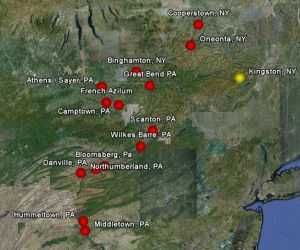 Twenty-five German families made their way to the Harrisburg area by sailing up the Hudson, and then down the Susquehanna, years before other Germans got there by way of Philadelphia. The trip, re-traveled.
Twenty-five German families made their way to the Harrisburg area by sailing up the Hudson, and then down the Susquehanna, years before other Germans got there by way of Philadelphia. The trip, re-traveled.
 The earliest tombstone in the Humelstown Lutheran cemetery is dated 1700, and William Penn acquired Pennsylvania in 1681. The Fisher geneological society traces most central Pennsylvanians of that name to Sebastian Fisher who arrived down the Susquehanna around 1690. At some time in the early history of the state, a group of twenty-five German families from the Rhineland set sail for William Penn's haven of religious freedom. The captain of their ship mysteriously refused to land in Philadelphia, and deposited the pilgrims in New York where they encountered serious Dutch animosity. Thinking things might be friendlier in upriver Kingston, they were again disappointed. It is related that Governor Keith of Pennsylvania happened to be in Kingston for a conference, and suggested the alternative route of floating down the Susquehanna, but Keith's visit was in 1722. Whether this was a separate immigration group or whether they spent 25 years in Kingston, is unclear. Presumably a number of immigrations took place over several decades, and their histories have merged into a single legend. There are many families of the same name, scattered up and down the Susquehanna today.
The earliest tombstone in the Humelstown Lutheran cemetery is dated 1700, and William Penn acquired Pennsylvania in 1681. The Fisher geneological society traces most central Pennsylvanians of that name to Sebastian Fisher who arrived down the Susquehanna around 1690. At some time in the early history of the state, a group of twenty-five German families from the Rhineland set sail for William Penn's haven of religious freedom. The captain of their ship mysteriously refused to land in Philadelphia, and deposited the pilgrims in New York where they encountered serious Dutch animosity. Thinking things might be friendlier in upriver Kingston, they were again disappointed. It is related that Governor Keith of Pennsylvania happened to be in Kingston for a conference, and suggested the alternative route of floating down the Susquehanna, but Keith's visit was in 1722. Whether this was a separate immigration group or whether they spent 25 years in Kingston, is unclear. Presumably a number of immigrations took place over several decades, and their histories have merged into a single legend. There are many families of the same name, scattered up and down the Susquehanna today.
It was eighty miles overland from Kingston to the upper reaches of the North Branch of the Susquehanna, but then it was possible to sail south to Lancaster County, where topsoil was reputedly rich and fertile. Although that was a long trip for those days, it was possibly less arduous than coming overland from Philadelphia to the same destination. Peak immigration from the Rhineland to what would later be called the "Pennsylvania Dutch" country occurred around 1730, so these adventurers were able to pick the best land for themselves, and became the leading families of the region, decades before it became white man's territory. Governor Keith himself was involved in a rather notorious copper mine venture, on the west side of the Susquehanna. The Indians may have presented a risk at that time, but reports of conflict were infrequent until the unfortunate episode of the "Paxtang boys" during the French and Indian War. If the settlers behaved themselves, it was safer than it sounded.
Although the exuberant western frontier is said to have reached the Susquehanna about 1820, the preceding century brought many pioneers through the Dutch Country. Living on the richest farmland in the world, descendants of the early settlers displayed little interest in joining the passing parade and were content to sell Conestoga wagons and Kentucky rifles to those who felt the need for more western adventure.
Details of the early pilgrimage are hard to find. We relate here the observations of a modern traveler, trying to follow the conjectured route, observing its present natural beauty, and commenting on the highlights of intervening history.
Headwaters of the Middle Atlantic Rivers
When Governor Keith suggested to some German wanderers that they might reach the Susquehanna River by walking eighty miles west from Kingston NY, he had probably never tried that route himself. Two mountain valleys converge toward Kingston on the west bank of the Hudson and were ideal routes for Indians to bring their furs to the Dutch trading post, later to become a whaling port. Taking the northern valley to arrive at what is now Cooperstown NY, the traveler discovers a beautiful mountain lake creates the Susquehanna River, much as Lake Geneva in Switzerland creates the Rhone, giving credence to the claim that Geneva is the most beautiful city in the world. Alternatively, taking the more southerly valley west from Kingston brings a traveler first to a mountain bowl from which several creeks run in different directions, before descending to what is now Oneonta on the Susquehanna. Just which valley the twenty-five German families actually followed in 1687 or so, is presently uncertain but either route would get you to the river after hiking about eighty miles. From either place, it is possible to float about four hundred miles downriver on a flatboat, to the famously rich topsoil of what we now call the Pennsylvania Dutch country. If you took it today it would be a terrifying ride, and in the 17th Century, it must have been much more so. First, you go south, then north, then west, then southeast, then southwest, then southeast again, as the North Branch of the Susquehanna finds openings in the mountain ranges, eventually emptying into the Chesapeake Bay four hundred miles to the south.
The reader may choose to follow that route (by automobile on roads closely paralleling the river), for which, clicking on the Philadelphia Reflections Topic called German Immigrants via New York are comments on the three hundred years of history that subsequently affected this first, founding, westward frontier. But it's still a mountainous wilderness for the most part, quite effectively dramatized in the movie How the West Was Won. The history of America was once regarded as the history of a moving frontier; the one which began here and ended up around 1900, in Arizona.
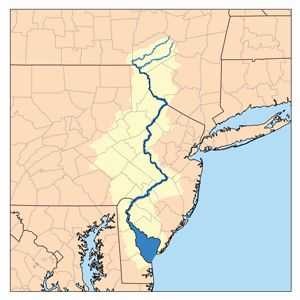
|
| Delaware River |
So focus first on the Mid-Atlantic tri-river watershed, the eighty-mile area west from Kingston NY. Some collision of ancient plate tectonics caused the North-South Appalachian mountain ridges to bend sharply at about the level of New York City, resembling a jumble of little mountains which subsequent glaciers ground down and smoothed out. The series of vertical ridges we call Appalachia more or less all bend sharply eastward at this level and the rivers consequently run in various directions, away from that center. The watershed of the Hudson runs along its banks for a few miles, the Susquehanna finds its way among the mountains eighty miles to the west, and Delaware gets snuffed out between them. When things sorted themselves, the streams had found their way into three main pathways, roughly parallel as they flowed south on their way to the sea. There's another way to look at the result. When the prevailing winds blow cold air from Canada across the Great Lakes, they pick up vast amounts of moisture which is dumped on upstate New York in huge winter snowbanks, or simply rain and fog the rest of the year. This massive rainfall system generates the water for three large river drainage systems. There's one more point of amateur geology: the advancing glaciers scraped the topsoil from the top of the land down to and over the mountain ranges and then dumped topsoil on the southern Pennsylvania counties as they receded. The German settlers of our story were seeking to get around the rocks and pebbles in order to live in eternal happiness in Lancaster County, PA. Governor Keith had somehow been told of this geography from Indian tales, and the scattered reports of white explorers confirmed it. You have to be pretty desperate to stake your family's survival on such reporting.
In any event, the settlers did give it a try, taking either the northerly or the southerly passage out of Kingston. Present hindsight suggests the southern route was shorter, but the northern route was more scenic. So scenic in fact that two prosperous residents of 18th Century Philadelphia bought up large tracts of land. Judge William Cooper of Camden (father of James Fennimore Cooper) bought 10,000 acres around Cooperstown, and William Bingham bought up a region he never visited, now called Binghamton, NY. The area is also noted for the much later construction of the main IBM calculator factory, and for the fact that I was married there, immediately spiriting the local girl back to Philadelphia where I belong.
Great Bend: Joseph Smith Translates the Golden Plates
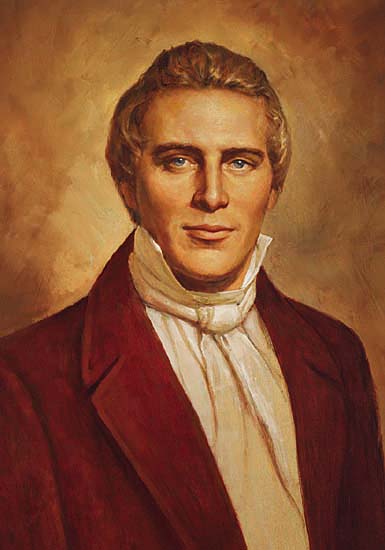
|
| Joseph Smith |
As the traveler up the Pennsylvania Turnpike Northeast Extension approaches the New York border, there's a chance for a fleeting glance at an exit sign pointing to Great Bend, without additional comment. The comment is definitely needed because a ten-mile detour at this point is rewarded by two interesting attractions. In the first place, the Susquehanna does indeed make a great bend there. Starting in Cooperstown, New York at a beautiful mountain lake which resembles Lake Geneva in Switzerland, the Susquehanna heads south for ninety-six miles and then turns around at Great Bend and goes back fifteen miles north to Binghamton. After that, it goes west for forty miles to Sayre and then goes south again as it picks up other branches. Greatly enlarged, it reappears to Turnpike travelers at Wilkes Barre. Thousands of travelers have sped up the wide valley without noticing that the same river which flows south from Wilkes Barre apparently starts flowing north at Great Bend. The traveler's eye is deceived by the apparently continuous long valley which the highway follows. At Binghamton, the Susquehanna starts flowing west, but that too is overlooked in whizzing past the cloverleaves and traffic directions. The Great Bend itself is a lovely water gap with a couple of small towns on its shores, but is otherwise pretty deserted.
For two and a half years, Joseph Smith the founder of the Mormon religion spent full time five miles away from the Turnpike exit, at the real bend in the river (not the town of Great Bend) writing the 275,000 words of the Book of Mormon. Although Smith was a native of Palmyra, New York, and Mormonism is most easily viewed as an outgrowth of wide-spread religious uproar in upper New York State during the 1820s, it undoubtedly provoked malicious gossip from those who resist all claims of miracles, as well as staunch defense from those who believe. It's comparatively safe to say the prophet was living at the Great Bend in his wife's tiny home while she wrote down his dictated translation. The source of his vision was said to be John the Baptist, which others have since taken literally to varying degrees. Those who believe in the pregnancy of virgins and reappearances after a death must be tolerant of the sometimes overstated beliefs of others. Smith never let anyone see the golden plates from which the writings were derived, however, and ultimately it must rest that he was relating what he believed he had seen. His father-in-law described him as a charlatan, an attitude not completely rare among other fathers in law. His wife, caught between conflicting family loyalties, declined for years to join the religion that flowed from her own pen.
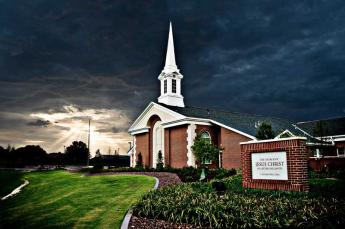
|
| The Church of Jesus Christ of Latter-day Saints |
However, with the publication of the Book of Mormon, Smith rapidly gained adherents numbering in the thousands. He moved the center of the religion westward in several steps and was shot to death by a mob, variously styled as militia and vigilantes, in Illinois at the age of 38. Just who killed him and what the motives were are matters we normally leave to courts rather than newspaper accounts. There is little doubt that many other religions of the time were outraged by the tolerance of polygamy, and so the account that he was assassinated by offended husbands of those to whom he proposed marriage, must be somewhat discounted. All religious disputes have a tendency to get out of hand, and the frontier religions of that time were particularly feverish, flaring up in an environment of the rule of the six-gun.
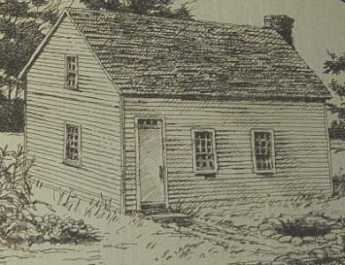
|
| Joseph Smith House |
The attraction of this religion seems to an outsider to have been based on its forgiveness for sinners, offering them tolerant heaven rather than the vindictive hellfire and brimstone which more puritanical protestant sects at that time envisioned for even well-behaved converts. There is a certain echo in Smith's Mormonism of the tolerant Quaker view that "There is that of God, in everyone." Similarly, although it is difficult to accept his idea that the American Indian tribes might be descendants of a lost tribe of Israel from the 7th Century B.C., the Mormon, and Quaker, teaching of tolerance to the Indians was in keeping with changing racial views in the early 19th Century, and softens somewhat the former Mormon distrust of the black race; although that, too, must be seen in the context of the then-approaching Civil War.
The best-known feature of this religion used to be polygamy, however, which is difficult to defend with theological, demographic or even romantic reasonings. With a few exceptions among Mormon extremists, the religion has moved away from any defense of polygamy. As the center of Mormonism moved to Utah, Congress outlawed polygamy, and the church officially condemned the practice and gave it up. Since it is still not rare to encounter a kindly decent gentleman on the streets of Salt Lake City whose grandmother or great-grandmother had been a polygamous wife, the whole subject has come to be treated there as an ancient embarrassment, best left unmentioned, but never quite forgotten. As a matter of fact, all religions have so much to account for in their past that they are most fairly judged by the sort of behavior they seem to inspire in their followers. By that standard, the earnest, decent, hard-working Mormons of today have earned their right not to be sneered at.
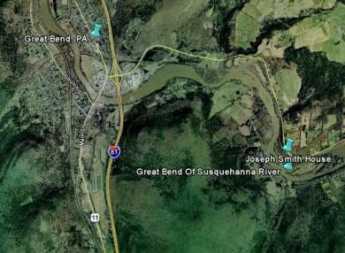
|
| Great Bend PA |
As for the simple little memorial along the river, it may seem a disappointment to some. It has not been made into a tourist attraction or a place of pilgrimage. It may even be a little unprotected from vandalism. But is surely worth the small trouble to visit, adding only half an hour to anyone's trip. One does not have to accept either the history or the theology in order to wish to see the place, which is a sweet little neglected clearing with a railroad running between it and the river. As a backdrop, the great bend in the Susquehanna is a remarkable sight in itself, because the river seems to be running in the wrong direction while no one notices. But one final double-take about polygamy simply cannot be resisted. One of the members of the Right Angle Club spent many years in the Middle East as a diplomat, where every Muslim man is permitted to have four wives. He reports that the younger Muslim men will often have nothing whatever to do with polygamy. Having watched the scheming, conniving jealousies of that custom from a front-row seat, the sort of Arab who always wears western clothes has firmly decided from personal observation that one woman, or at least one woman at a time, is quite enough.
The newspapers tell us a Mormon tabernacle or church may soon be constructed near the new Barnes Museum on the Parkway in Philadelphia. It could even resemble the one in Washington DC, with a statue of the Angel Moroni, blowing a gleaming gold trumpet. The Mormons seem to want Philadelphia to notice them and form an opinion, which indeed we probably will.
La Cosa Nostra Has an Apalachin Outing
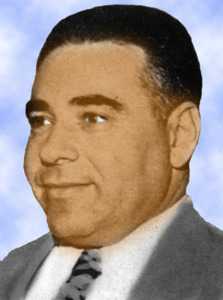
|
| Joseph Barbara |
It's hard to convince people of something they don't want to believe; others are simply determined to deny they already know it. In any event, prior to 1957, it was vigorously denied by many Americans of Italian descent that there was any such thing as organized crime, The Mob, The Mafia, or La Cosa Nostra. One of the pieces of evidence for regarding organized crime as just an anti-Italian slander was the consistent denial by the head of the F.B.I. J. Edgar Hoover that a national crime syndicate existed. Just why Hoover took this strange position will have to be left to future historians. But even J. Edgar Hoover couldn't deny it after November 14, 1957, when New York State Police surrounded a hundred mob bigwigs, lieutenants, and bodyguards at Apalachin, NY.
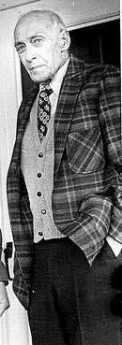
|
| Sgt Edgar Croswell |
New York State troopers always kept a watchful eye on a fifty-acre estate belonging to Joseph Barbara the reputed boss of Central Pennsylvania crime, located just within New York state borders; it is not necessary to invent a feud with one trooper, or insist that some disgruntled criminal tipped him off. When all local motels were suddenly booked up, and dozens of expensive automobiles with out-of-state licenses could be seen parked in the estate, it was only prudent to check the license numbers. When the report came back that most of the cars belonged to persons suspected of leadership in organized crime, it was reasonable to establish roadblocks around the estate, just in case. And then, after a car sped in past the roadblocks, soon followed in reverse by dozens of adult males fleeing in suits into the surrounding woods, it was natural enough to pick them up for questioning. It's estimated that fifty of them got away, but 58 mob bosses, henchmen, and bodyguards were caught and indicted. Everybody, it seems, had heard that Joseph Barbara was feeling unwell, and they had come to inquire after his health. Local lore has it that for years, wallets filled with hundred dollar bills were to be found tossed into the nearby underbrush.
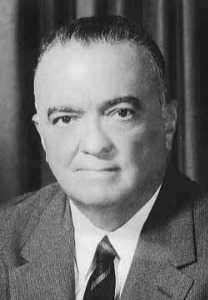
|
| J. Edgar Hoover |
A great deal has been said and written about what was really going on, although a lot of it is probably deliberate misinformation, and some of the rest is couched in "weasel words" intended as some sort of code. The present general opinion is that the old-style Sicilian Mafia had engaged in a war for several years with upstart "Liberals" and that this meeting was intended as a peace treaty of the "Crime Commission", for which some crime bigwigs from Italy had been imported as referees. Grander visions, including the extension of crime syndicates into Cuba, Las Vegas, and California were on the agenda but were not the primary agenda. It was rumored that Angelo Bruno of Philadelphia had been newly appointed to the Commission, and was leaning toward favoring the "Liberal" faction. Such a disruption of leadership as the Apalachin round-up naturally resulted in a large number of assassinations, imprisonments, novels, and movies. This was the final, undeniable, outing of organized crime. The mob was finally turning away from the giddy days of prohibition rum-running, toward more modern entertainments like recreational drugs, gambling, and loan sharking. The Sicilians were losing control to Italians and Jews. The public was going to movies and reading books; it was becoming inevitable that the "goddam innocent bystanders" and other do-gooders were going to demand that this sort of invisible empire simply had to be curbed
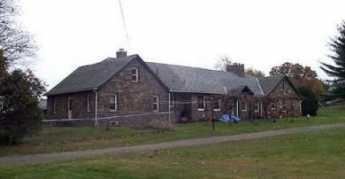
|
| Joseph Barbara's Place |
Just why Apalachin was selected is debatable. It's visible from the Interstate Highway, and state roads run by the estate. It's quite close to the Susquehanna River, for whatever value that might have to organized crime. It's, therefore, both private and remote, as well as within a couple of hours easy drive to most East coast cities. And its back road runs straight to Hazelton, which might seem a more natural place for the boss to live, except that Apalachin was just over the state line for legal purposes. The verbal history circulated within knowledgable circles is that the Mafia started in Sicily in response to resistance to Italian authorities, especially Garibaldi. When it got to be time to move, they first went to New Orleans. Unable to cope with the Ku Klux Klan, however, the pilgrims split into two main movements. One went to South Philadelphia, and the other went to Hazelton. After that, the links to New York, Chicago, and Las Vegas are obscure.
So, Apalchin is worth a drive-by. Those who are timid can get a fairly good idea from Google Earth.
Sayre / Athens
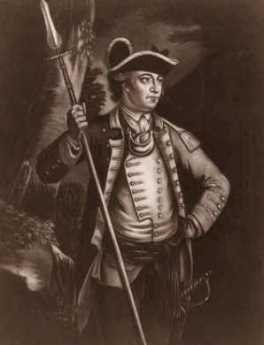
|
| General John Sullivan |
Running west from Oneonta and Binghamton, NY, the North branch of the Susquehanna runs due west for about fifty miles until it turns abruptly south at Sayre, PA. In the course of this westward run along the northernmost ridge of the Endless Mountains, it passes Apalachin NY, where the mobster chieftains got caught by the state police while holding a convention. At Sayre, named after an eastern railroad financier of the 19th Century, it joins the Chemung River at a large bowl-shaped refuge in the mountains which shelters it somewhat from the ferocious snows for which this part of Upper New York State is famous. Sayre usually gets a heavy snowfall or two in January, which lies on the ground until the Spring thaw in April. But that's pretty mild for this region, and the Iroquois made it a sort of headquarters, where Queen Esther of head-smashing fame made her home just before the Wyoming massacre in which she figured so prominently. Consequently, General Sullivan made his famous march to destroy the Iroquois by going northwestward up the Susquehanna to Athens, rather than following the Northeast Extension of the Pennsylvania Turnpike, as somehow seems more probable. Actually, Sayre was more of a 19th Century town, with the original settlement concentrated a few miles south at the region of Athens. Sayre is more modern, once was the location of a huge locomotive repair center, and has the Guthrie Medical Clinic at Robert Packer Hospital. Athens is older, quieter and has more stately charm, and is actually on the Chemung River with a two hundred yard portage to the Susquehanna.
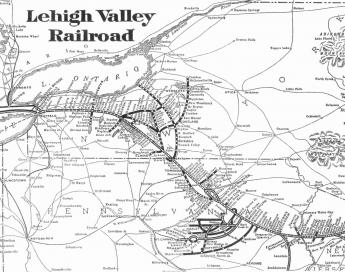
|
| Lehigh Valley RR Fame |
Robert Packer was considered to be the ne'er do well son of Asa Packer, that go-getting industrialist of Mauch Chunk/Jim Thorpe, and Lehigh Valley RR fame. The father is said to have sent his son up to Sayre to get him out of the way, but once freed of the old tyrant's grip, Robert built things up into the second-largest locomotive repair center in the world. Robert Packer never had children and eventually set about building up the Robert Packer Hospital. Much taken with the Mayo Clinic model, he called Charlie Mayo and asked if had someone to suggest for running the local institution. Indeed, Mayo had just the fellow, Guthrie, who like the Mayos was a surgeon with a specialty in removing enlarged thyroid glands. As long as the railroads flourished, the Guthrie Clinic was headed toward the status of a major medical center with private rail cars for the surgeons and the like. However, the advent of diesel locomotives put an end to the main source of local prosperity, and the Guthrie Clinic settled down to a more modest status of a regional medical center, mainly in competition with the Geisinger Clinic further south on another bend in the Susquehanna. At present, the Obama Administration seems much taken with the model of the Midwestern group practice, of which both Guthrie and Geisinger are models. Perhaps the politicians do not realize that all of these clinics were based economically on the principle that surgeons can make enormous incomes if they are fed enough cases. Consequently, they are willing to reduce their own income in order to make group practice more attractive to the "feeders"; the department of surgery subsidizes the department of general medicine. Their competitors have long grumbled that this arrangement was an elaborate evasion of the medical ethical prohibition of fee-splitting. Most of that feeling has subsided, but a more serious present criticism is that the Obama Administration mainly seems determined to reduce surgical fees, so the whole arrangement may collapse when they do.
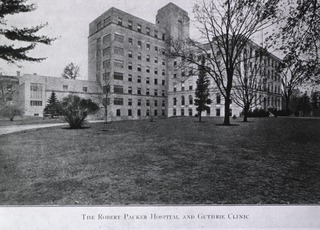
|
| Robert Packer Hospital |
Curiously, prosperity looks as though it may be ready to return to the Endless Mountains, in the form of the fracking method of gas extraction from the Marcellus Shale which underlies this region. Coming as it does at a time when domestic oil production is growing inadequate, but alternative energy sources are not yet competitive, rail freight is returning to the region, and truckers by the thousand are migrating from economically depressed regions like Detroit. For reasons not immediately clear, the huge trucks which import water and chemicals for fracking are driven by non-residents. The smaller trucks which carry away (to Northern New York, they say) the brine effluent from the wells, are driven by locally recruited truck drivers. A certain number of bar room fights have been rumored to have grown out of this situation. Camp followers of the fair sex have occasionally drifted into town, but so far not in large numbers.
As the region has evolved, the third town of Waverly NY has joined the other two in what amounts to a seamless conurbation of about 30,000 people, nestled in the cozy valley.
Shale Fracking Arrives in Pennsylvania

|
| Drilling for Gas |
As background for this story, let me say that I want to preserve the environment as much as anyone else. After considering the matter, it seemed to me that the largest contribution I could make to the "greening" effort would be to replace my home heating oil burner with a gas burner. That would improve my efficiency from 68% to 97% (or reduce the waste going up the chimney from 32% to 3%) of about 2600 gallons of fuel oil a year. The initial investment would be repaid in about three years, our dependence on imported oil would be reduced about as much as I could reduce it, and there was apparently a new abundant discovery of reliable gas production nearby. Compared with this, I barely use a tenth as much gasoline in my car, so potential savings in a hybrid car would seem trivial by comparison. And, sorry, I'm just not going to plant sedum on my roof, or dig water well through bedrock, or put a windmill in my front yard. Going to a gas furnace might be my big contribution to the environment, at least for the present.
It is, however, distressing to hear stories of gas wells poisoning water supplies, tearing up the roads, and destroying whole species of birds in their annual migrations. So, it was time to go look for me. My guide was an acquaintance of an acquaintance who lived in the midst of the gas region, a retired sergeant from the professional Army who had found the cost of living in the Endless Mountains was quite moderate, and just about everybody in the county was related to him or his wife. Mike will forgive me for saying he physically resembles Sergent Snorkel in the Beetle Baily cartoon but has the personality of everyone's favorite uncle. It's a three-hour drive into the Endless Mountains (that's really the name) in the center of the northern tier of Pennsylvania's counties. The big local town is Montrose, which has only one traffic light, only one police car, and only two policemen. It's really a charming little town, where nothing seems to have happened for excitement since the days of the Underground Railroad, whose headquarters still stands a block from the county courthouse. Montrose is the county seat of Susquehanna County. If this was the environment that gas fracking was going to destroy, that would be a pity.

Except the people who live there don't think so at all. At first, the gas drillers came around and offered the farmers $25 an acre for drilling rights, but competition soon established they were worth closer to $1000. The conjecture is that Susquehanna County was singled out for early exploration because it is already crossed by the Tennessee pipeline, and thus the early gas discoveries could be quickly marketed. The full extent of the Marcellus Shale deposit is from Canada to Texas, although it may prove to be patchy, and its estimated content is greater than that of Arabia. Since there isn't much to talk about in Montrose except the deer hunting season, the drilling employees are a ready source of information about something local that is very big, very big indeed. The employees work 12-hour shifts, seven days a week for six weeks, and then have two weeks off. If that's too much for you, plenty of people can be imported from the Detroit area to drive trucks. There are essentially no hotels, so they live in rented rooms, and they like to talk to the locals.

|
| Farmland |
It costs a million dollars to drill each well, and they finish it in three weeks. The work actually begins earlier, as a stone is quarried and crushed to construct a level platform. Then, glorified dumpsters on wheels are rolled to the site, the well goes up a hundred or more feet, and the sand, water, and secret chemicals are pumped seven thousand feet into the ground. Lateral drilling goes on at three thousand feet underground, and connections to neighboring wells go out at various levels. It a giant beehive of activity in the cornfield for three weeks, and then it's all over. The derrick comes down, the dumpsters are dragged away, the top of the well is capped. It takes about six months for the weeds to take over, and just about all that is left visible amounts to a rather large fire hydrant, sticking up ten feet in the woods or corn field. It is a considerable relief to hear that water injection ceases after the initial three weeks; visions of lakes and rivers drying up forever are not likely. The drilling companies are quite sensitive to the appearance they leave; as is sometimes said of good artisans, they are careful to leave a clean site when they leave. Yes, the heavy truck traffic breaks up roads, but mostly the roads were one-car wide and have been enlarged to all-weather two-lane roads by the drillers themselves, the local residents are quite proud of the improvement. In their eyes, the place looks a lot better. Since the region participates in the astonishing snowfalls for which Syracuse and other upstate New York cities are famous, there is a great deal of relief from the winter-long isolation caused by mounds of snow. As far as contaminated water is concerned, the water injected into the wells is trucked in from elsewhere in those wheeled dumpsters. As the technology evolves, the tendency now is to mix the sand and surfactants on the spot, when originally they were mixed off-site. Much of the used brine is pumped back out and evaporated on large plastic sheets, washed, and the residual sand is reused. Far from cutting corners, these drillers seem to be going to extremes to avoid complaints. And then, of course, there is the money they pay for drilling rights.
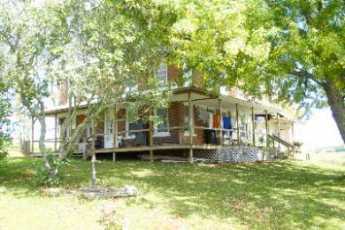
The most famous example of drilling royalties is known to every local, shown to every visitor. Owning 180 acres close to the pipeline, one widely-admired citizen is believed by everyone to be receiving $180,000 per month and will continue to receive it until the gas runs out. The rather large farmhouse could use a coat of paint, and as was made famously true in the play "Tobacco Road" the laundry is done on the porch and dried on a clothesline, also on the porch. The neighbors' joke that it has gone to his head because three new automobiles sit in the yard. One wisecrack was that he must have been playing the tuba on a day it rained gold. He, however, isn't a rarity, a great many neighbors for miles around are getting similar windfall payments. That seems to have two immediate consequences.
In the first place, it marshals local opinion strongly on the side of the drillers. One is not surprised to learn they hate taxes, favor depletion allowances, and generally take positions common in western Texas. One pert little hamlet in the valley has gone to court to insist on piped-in drinking water because methane gas bubbles out of their faucets. Just before an election, a local court granted that request in spite of learning that the water will cost $650,000 per house, more than most people would say the houses are worth. Local neighbors are far from sympathetic to this cause. They firmly believe the drilling company offered to solve the problem at far less cost by drilling wells with purification systems, but the lawyers advised their clients to hold out for bigger windfalls. It is widely believed by neighbors that gas has been bubbling out of well water in that region for a hundred years. If by any chance this legal action should kill the goose that laid this golden egg, these deer-hunting, gun-owning royalty recipients seem entirely capable of making an uncomfortable showing. Pennsylvania elects its judges, its legislators, and its congressmen. No doubt candidates for the November 2 election have been questioned for their views, and will learn the voters' views November 3rd.
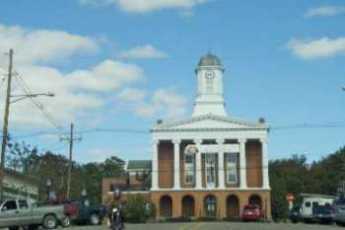
|
| Montrose Courthouse |
The other response is just as expected as that one, and is called "The Dutch Disease" by economists. As these windfall enrichments seep out into the local community, the local economy will be upset just as the Dutch economy was upset by the discovery of oil and gas in the North Sea. Everyone would rather work for the drilling companies than for established local industries if indeed they see any sense in working at all. The clearest indication of what is coming is seen on a large sign attached to an old storefront: "Investment Advice Offered". It takes a long time to learn that the main difference between a good investment and a bad one is the hidden fees you pay. Not market timing, not stock picking, not diversification, not hot tips. Fees, charged by your new best friend, are the thing. So, here are two pieces of advice: investment management in size is worth 40 basis points or four-tenths of a percent; that's it and that's all. And the second piece of advice comes from your Pennsylvania grandmother: don't marry the first man who asks you.
And what are the rest of us to make of this shale gas thing? Well, I've already installed a new gas furnace in my house, the supply of gas seems assured enough for twenty years. Any politician who tried to tax this windfall out of existence will soon see what the political realities are. The environmental realities are quite favorable; once the drillers have stopped injecting water and taken down the equipment, there's not much to see except a ten-foot fire hydrant surrounded by weeds. All the connections are buried underground, leading to terminals many miles away. At first, the drillers may feel they need to post some guards, but it surely won't be necessary. The locals are convinced, and the environmentalists only need to drive up on a weekend and see for themselves.
Azilum: French Asylum on the Susquehanna
Off with their heads!, she said. They have refused my cake in preference of moldy bread, by God"
Wilkes-Barre, Site of the Wyoming Massacre
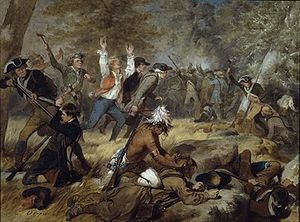
|
| Wyoming Massacre |
For eons of time, the site of Wilkes-Barre, PA was once a sort of finger-lake between two mountain ridges. As dammed-up rivers tend to do, this one gradually filled up with sludge until the water spilled over at Nanticoke, a few miles to the south. After the lake drained out leaving the original river in place, there was also left a flat and fertile valley on either side of it. Furthermore, the towering mountain ranges on either side protected the valley from the weather, so the Wyoming Valley became a verdant paradise in the middle of the mountains. Somehow, the Congregationalist settlers of Connecticut found out about it, dug up some old deeds from King Charles to the effect it belonged to Connecticut, and eventually set forth to resettle in this mountain valley. Pennsylvania took offense at this, and the result was three little wars which few people have heard of, called the Pennamite Wars. The local Indians were most offended of all and did the most massacring in a very thorough way. During the Third Pennamite War, George Washington was at Valley Forge with more urgent matters on his mind, and dispatched General Sullivan to "take care" of the Indian problem; Sullivan did so in a very thorough way, essentially destroying the Iroquois nation. The other eleven colonies were distraught to see Pennsylvania and Connecticut putting on a side-show, and part of the judicial settlement was to give Connecticut the "Western Reserve" in Ohio as compensation for restoring the peace. The American Constitution of 1787 essentially made state possession of land a moot point, and the Western Reserve is just a quaint term you hear in Cleveland. Wyoming is a term that most people associate with a Western State, although it is named for this valley, and Dallas is another term that has been largely transplanted from a small town near Wilkes-Barre to a big town in Texas. So, if you want to get the confusion of terms straight, about Wyoming, Dallas, Western Reserve, and Westmoreland, you will take a little time to learn about Wilkes-Barre. Westmoreland is the name of gentleman's club in Wilkes-Barre, but it is also the name of a county near Pittsburgh where Connecticut folks thought it would be useful to flee.
That's a lot of history for a little town, but there's more. Somehow, the joys and pleasures of living in the Wyoming Valley were carried back to people like Rousseau, who were looking for examples of the "noble savage", noble because he had not learned all of the evil things that French aristocrats invented, and therefore warranted effusive praise during the so-called Romantic Period, when France was being purified by the guillotine. The main drum-beater for this mania was a poet named Thomas Campbell, who composed a long poem in Spencerian rhyme called "Gertrude of Pennsylvania". Even those who find merit in Spencer will nowadays find it difficult to accept the notion of flamingos on Pennsylvania streams, or lying on the ocean beaches of Pennsylvania, reading Shakespeare. Even those who have less taste for Herbert Spenser will still find a reason to distrust the judgment of those who praise the beheading of, say, Lavoisier. The noble savages in this particular case were Iroquois, who exterminated 600 settlers by essentially torturing them to death.
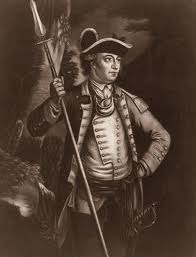
|
| General John Sullivan |
There's a memorial in nearby Wyoming commemorating this massacre, which indeed is probably better left forgotten. There are plaques with the names of the fallen, and the names of the survivors. The idea of the Wyoming Valley as a paradise on earth was destroyed by another event. The ancient lake which once filled the Wyoming Valley was deeper and more ancient than anyone guessed. Underneath the rich topsoil was a vein of anthracite, and Wilkes-Barre became a boom town with strip mining, a fate no paradise can long withstand. There is nearby said to be a coal mine which caught fire underground and has been burning uncontrolled for several decades. Talk about pollution disasters; this one is a monster.
Reliable records of how the Connecticut Yankees got to the Wyoming Valley are hard to find. Offhand, it is puzzling to wonder how they got past New York or crossed the Hudson River. The best way to get between the two places today is probably pretty close to the route the colonists took, however, because travel in those days was much more constrained by geography. We know they started from Litchfield, CN, and in fact, for a while, Wilkes-Barre was part of the County of Litchfield. From Litchfield, they likely crossed the Hudson near Newburgh, went to the mountain gap at Port Jervis, and either came into the Wyoming Valley over the ridges or went a little north to the Susquehanna and came down from there. On a map at least, that's a relatively straight shot.
Wyoming, Fair Wilkes Barre
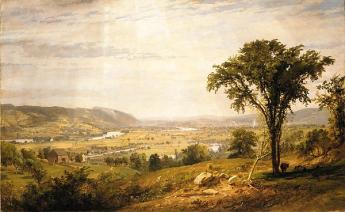
|
| Wyoming Valley |
There are a dozen or so places on the planet where a natural bowl formation famously moderates the climate. Cuernavaca in Mexico, the Canary Islands, and Chungking in Western China all claim to have temperatures which range from 70 to 75 degrees Fahrenheit, year-round. In Cuernavaca at least, they claim it only rains at night. These three places have a high plateau in the center of a mountain bowl, like an angel food cake pan, which may (or may not) contribute to the unusually mild climate effect. Several other places within inner China compete for the title of Shangri La, famous in song and story, never precisely located by tourists. The Wyoming Valley of the Susquehanna River once enjoyed a similar luster during the Romantic Period at the very beginning of the Nineteenth century, although unfortunately, its temperature is plainly not so balmy. Wyoming of song and poem was imagined to be the home of the Noble Savage, unstained by the wayward influences of civilization, and thus a model for the democratic ideal expected to emerge in Old Europe once the aristocrats were exterminated by nature's noblemen, European version. That seems to have been Robespierre in France, as disappointing to idealists as the Iroquois along the Susquehanna.
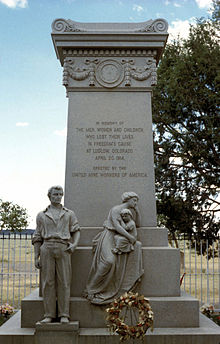
|
| Massacre Monument |
But one must not scoff. The Wyoming Valley was created long ago by a lake between two mountain ridges, which gradually dried up leaving flat topsoil deep at the bottom of the valley when the river finally broke through at Nanticoke and drained it. Its appearance is enhanced by surroundings in all directions of at least fifty miles of bleakness. Nowadays, the best way to appreciate the natural beauty of the place is to arrive from the south, gaining the summit of the ridge by one of the secondary roads. Housing development down below stops at the edge of the level plain, so as one ascends to the southern rim it is possible to see the inside of the bowl without seeing much of the town, and thus appreciate how it must have looked to frontiersmen searching for likely places to settle. It's quite beautiful. Descending into the bowl, the potholes in the road and roadhouses along the way to begin to make an impression. In full sight, it looks as though a city suburb has filled the place to its edge, with a rather decaying Nineteenth-century town center, but towering wooded mountainsides. There's a quiet park in the very center, through which the quiet river runs. In a little subdivision named Wyoming, there is a monument to The Massacre, now described as a hopeless defense by untrained Revolutionaries against the fearsome Indians and British Loyalists. The names of the fallen and the names of those who escaped are carved on this monument near Forty Fort. One presumes the wounded and some bystanders were massacred, the officers and trained infantry were more likely to escape the hopeless odds by fleeing into the woods. It is claimed that common soldiers were finished off by Indian Queen Esther smashing their heads between two flat rocks. Wounded officers were tortured to death.
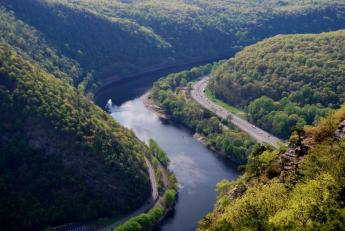
|
| Delaware Water Gap at Stroudsburg |
Just where the Connecticut immigrants, or invaders, first arrived in the Wyoming Valley is not known. Their most likely entrance was at the top of the northern end of the valley, where ski lodges now cluster, after coming up the mountains from the east. The hills rising from the Delaware watershed are wooded but too rocky for farming. It's therefore inexpensive to set aside parks named "Promised Land" and "The Lord's Valley" and such, with some Milford, scattered here and there in the woods. A section of the upper Delaware River fifty miles long, from Port Jervis down to the Delaware Water Gap at Stroudsburg is enclosed in a National Wildlife and Recreation Area of about a mile's width on either side of the river. It's surprising how little is said of this rather large national park close to two large metropolitan areas. No doubt the visitors are torn between wishing it was more appreciated, and hoping to keep it secret and unspoiled.
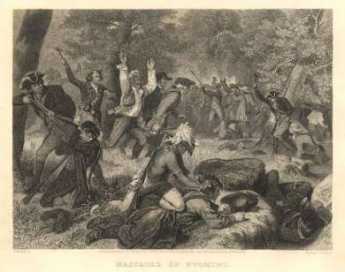
|
| Wyoming Massacre |
The Decision of Trenton(1782) simply gave the disputed land back to Pennsylvania. There is a strong presumption the Connecticut migrants were privately promised land in the Western Reserve, in Ohio, whenever Ohio became a state. In spite of the implicit guarantees, the Pennsylvanians nevertheless treated the usurpers pretty roughly, and traces of Connecticut trail westward toward the Ohio line. There's a Westmoreland County near Pittsburgh, where many stranded families in the bituminous coal regions can thus trace their ancestry back to the Mayflower. It is truly extraordinary that such bitterness could leave so little trace of itself later. History may not be bunk, but persistent grievances are surely a menace to a peaceful existence. The events of the Pennamite Wars are widely believed to have led to the slanting of the 1787 Constitution toward the protection of individual property rights, but the wording to that effect within the Constitution is hard to locate. Somehow, like the implicit promises of the Western Reserve, ways were found to provide credible promises that it soon wouldn't matter which state you lived in. Somehow the word got to John Marshall that in actual practice, what would matter was whether an identified person could demonstrate clear title to specific land back to, or a little beyond, 1787, no matter what state the land was in. And the obscurity of the complex connection between this revolution in the law of property, and the very sad events in the Wyoming Valley suited everybody concerned. Stare decisis.
Wyoming, Fair Wyoming Valley
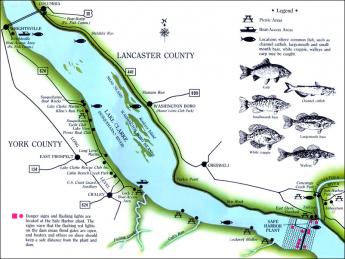
|
| Lake Clarke |
By 1750, or roughly ninety years after King Charles gave them their charter extending infinitely to the Pacific Ocean, the Connecticut Yankees with Old Testament first names had found their promised land was as disappointing as the King who promised it to them. So, two kings later, an exploratory party was sent west of the Hudson. The party returned with glowing tales of the Wyoming Valley in Northeastern Pennsylvania, just over the Blue Ridge Mountain. Only one white man had ever been there before them, Count Zinzendorf, the adventurous founder of the Moravian Sect.

|
| Iroquois |
The Wyoming Valley is certainly a jewel. It has comparatively mild weather as a result of being protected on all sides by mountains. The Susquehanna River runs through it, pinched by narrow valleys at both the top and the bottom, and filled with deep rich topsoil. In fact, it constitutes the remains of an ancient lake, whose Southern tip had broken through the Nanticoke Gap, draining the lake. It took another century or so to learn that underneath the topsoil was a thick deposit of anthracite coal. The Connecticut explorers were ecstatic about this little paradise in the mountains, and returned with news that it was everything the real estate promoters (The Susquehanna Company) wanted to hear. Indeed, the promotion of this valley almost got out of hand when news of it reached Europe at the start of the Romantic Period. Wyoming is what everybody wanted to hear about, the home of the noble savage. An epic poet named Thomas Campbell composed a long saga about Gertrude of Wyoming that caught the fancy of the Romanticists, with tales of Gertrude luxuriating on the ocean beaches of Pennsylvania, watching flocks of pink flamingos, and similar fancies, like Gertrude reading Shakespeare in the woods. In 1762 The Susquehanna Company sold six hundred shares to Connecticut adventurers, who were soon off to paradise.
The noble savages turned out to be Iroquois, who watched the new settlers on their land from behind neighboring trees. After a few months it became clear the white settlers intended to stay permanently in the valley, so one day the Indians emerged from the woods, and annihilated them.
Joseph Priestley, Shaker and Mover
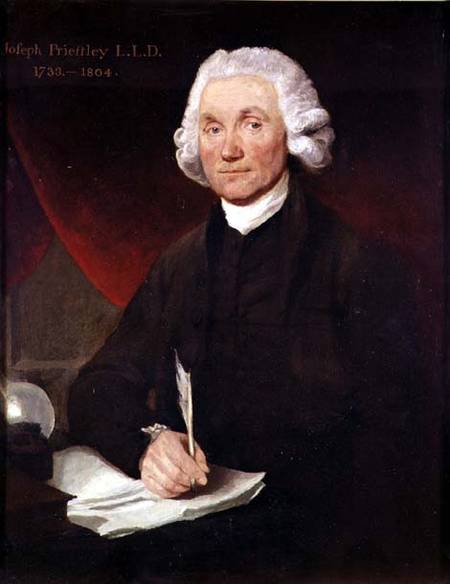
|
| Priestley |
Joseph Priestley, sometimes also spelled Priestly, is surely one of the more undeservedly neglected men of history. He has been called, with justice, the Father of the Science of Chemistry. He might also be called with equal justice, the father of the First Unitarian Church . The First Unitarian Church of Philadelphia, at 21st and Walnut, is the first and oldest Unitarian church and was indeed started at the urging of Priestley, whose principal residence was in Northumberland PA, at the confluence of the West and North Branches of the Susquehanna. Priestly wrote a scholarly work on the teachings of Jesus, which so captivated Thomas Jefferson that Jefferson wrote him the outline of another book that needed writing. Apparently, Priestley didn't have time, so in 1803 Jefferson wrote it himself, in the four languages he was fluent in, English, French, Latin, and Greek. Although those were simpler times, there have been few if any others who have told a President of the United States that he was just too busy to respond to a presidential request, particularly when the President could then find he had time to do it himself.
Priestley's theological teachings were based on scientific reasoning. They were highly controversial views, to say the least. He rejected the concept of a Trinity (he was a Calvinist minister, mind you), the divinity of Christ, and the immortality of the soul. Essentially, he rejected the concept of an immortal soul on the reasoning that perceptions and thought were functions of material structures in the human brain (Edmund O. Wilson's idea of Consilience is largely similar), and therefore will not outlive the cerebral tissue which produced them. In 1791, mobs burned his house in Birmingham, England, his patronage was revoked, and he hastily emigrated to Philadelphia. It isn't hard to see why these ideas were particularly unpopular with the Anglican church, which is probably the main reason England made him into a non-person, and his scientific ideas were denigrated as the product of other people.
That's too bad because he really was a scientist of immense importance. As a young man, he encountered Benjamin Franklin in England and was certainly a man after Franklin's heart. He noticed funny things about gases that rose from swamps and over mercury salts, and Franklin encouraged him to systematize and analyze his observations into theory. Although he called it anti-phlogiston, he had discovered oxygen. And then hydrogen, and nitrous oxide, and sulfur dioxide, and hydrochloric acid. Priestley really was the first organized and coherent scientific chemist, the Father of Chemistry. Franklin, Lavoisier, and Priestley became scientific friends, and enthusiastically exchanged ideas and observations, eventually leading to Lavoisier's fundamental principle: Matter is neither created nor destroyed, it only changes its form. In the end, it made no difference; Priestly had offended some pretty large religions, and nothing he did in chemistry was going to get much attention. Perceiving the value of the land at the confluence of rivers, he made his home for the last ten years of his life in Northumberland, Pennsylvania, now three hours drive Northwest, somehow managing to maintain an active scientific, political and theological influence worldwide. Visiting this rather sumptuous estate in a little river town is well worth a tourist visit. He died in 1804, just after his friend and kindred-religionist Thomas Jefferson became President of the United States.
Priestley's life can be summarized in one of his own most quoted remarks. "In completing one discovery we never fail to get an imperfect knowledge of others of which we could have no idea before so that we cannot solve one doubt without creating several new ones."
REFERENCES
| The Invention of Air: A Story of Science, Faith, Revolution,and The Birth of America, Steven Johnson ISBN: 978-1-59448-852-8 | Amazon |
Joseph Priestley of Northumberland, PA
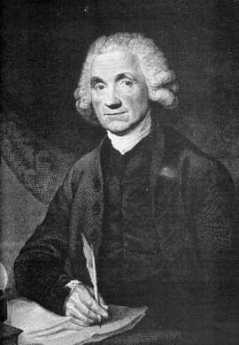
|
| Joseph Priestly |
There's one good thing about living near the confluence of two big rivers, and one very bad thing about it. The rivers provide transportation in three directions, but about once every twenty-five years the rivers rise astonishingly and threaten to carry everything away. That deposits rich topsoil, making it even more attractive for settlers to locate there. At what we now call Northumberland located on the junction of the North and West Branches of the Susquehanna, there is a monument marking off the flood levels of the past two centuries. Even the least of these floods must have covered a lot of ground, and the highest one is so far above the head of a visitor that it is hard to see how anything could have survived it. Right now, the little town of Northumberland is a burnished little jewel. One hopes the Army Corps of Engineers either has or soon will abate the potential flood danger. It would be interesting to know if flood insurance is available, just as a sign of how experts currently evaluate the risk. The Endless Mountains (that's really their name) stretching almost to Cooperstown, catch a lot of rainwater and snow and occasionally funnel it all down the North Branch to Northumberland. The West Branch is even bigger. Having observed the 1936 flood in Pittsburgh, I can testify it isn't an experience soon forgotten.
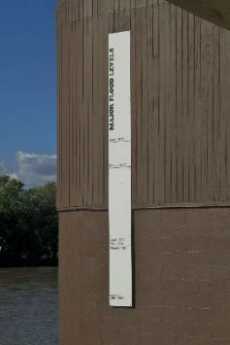
|
| Flood Levels |
It happens the most prominent resident of the area arrived there in 1794 and lived out the last ten years of his life as a widower. Joseph Priestley, an English dissenting minister had stirred up enough uproar to cause his house to be burned to the ground. No doubt, the English wanted to suppress any repetition of the French Revolution but were willing enough to be rid of a protege of Lord Shelbourne so the government made full restitution of the value of his property when he finally agreed to emigrate. Pennsylvania was chosen on the advice of his good friend Benjamin Franklin. He bought extensive land at the river junction and constructed what most people would describe as a beautiful mansion on reasonably high ground with a river entrance. Although it is built of wood and William Penn's Pennsbury was brick, there is a definite similarity. Priestley's house somehow seems more open and livable, although the outhouse reminds us that plumbing costs were moderate at the time. And furthermore, the original building survives as Pennsbury did not. The original plans for it were later discovered in England, and so it has been possible to make it what it used to be, outbuildings and all. Priestley and Lavoisier did not get along even though they share the honors for discovering Oxygen. Lavoisier was a rich aristocrat, while Priestley was a prominent member of the dissenting class with advanced ideas about democracy. It is said that many of the ideas Thomas Jefferson had about the natural rights of mankind were brought into sharper focus by his association with Priestley. Priestley was primarily a political theorist, acting in the role of a minister. He regarded his chemical experiments as a hobby, motivated by the hope of discovering a bridge between religion and science. The relationship between Priestley and Lavoisier was a strange one, but it had political conjunction as well as a scientific one. Priestley was driven to America by English Tories the same year that Lavoisier was guillotined by French revolutionaries.
Although oxygen had been discovered while Joseph Priestley was still in England, he discovered carbon monoxide in Northumberland, using retorts and scientific instruments he designed and sent to his friend Wedgwood to manufacture. He also devised the idea of carbonated water while he was here. For these as well as chemical methodologies he has been described, at least by Anglo Saxons, as the Father of Chemistry. Following what he considered to be his main occupation he meanwhile founded the Unitarian Church in America. In the little town at the Susquehanna forks, he was unable to establish a viable Unitarian congregation beyond a few followers who came to his home. So, he somehow found the energy to establish the First Unitarian Church in Philadelphia, at 21st and Walnut Streets. (Aside from its historic significance, the present church building is a distinguished work of architecture designed by Frank Furness). Meanwhile, he was very active in national politics; Jefferson's defeat of John Adams' reelection is often ascribed to his efforts.
His wife died of tuberculosis before they could move into the Northumberland plantation, but he lived there with his son and daughter-in-law for ten years, dying in 1804. The son was concerned with founding a utopian colony, but the wealthy daughter-in-law forced a return to England. The grandson generation returned to Northumberland, where the graveyard now has an impressive array of Priestley tombstones.
REFERENCES
| The Invention of Air: A Story of Science, Faith, Revolution,and The Birth of America, Steven Johnson ISBN: 978-1-59448-852-8 | Amazon |
Bloomsburg / Danville
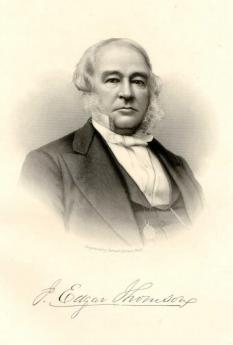
|
| J. Edgar Thomson |
The North Branch of the Susquehanna winds its way through the mountains of central Pennsylvania, particularly from Wilkes Barre to Danville. The zig-zag course of the river is confusing, with long stretches of westward flow reversing the long eastward flow between Binghamton and Sayre, between which are long stretches due south. At Danville, the river makes its final sharp turn and then begins a straight southern chute toward Harrisburg. The discovery of iron ore between Bloomsburg and Danville was just in time for the advancing railroads of J. Edgar Thomson, and the Iron King of the area was George Geisinger, whose widow Abigail founded the hospital of that name where the Geisinger Clinic now flourishes. As iron and steel moved west to the Pittsburgh region, the Geisinger Clinic now pretty much dominates the area, like a self-contained ocean liner at sea.
Around 1850, the county seat was moved to Bloomsburg, causing the irritated citizens of Danville to break tiny Montour County off from Columbia County, and making Danville at least the county seat of some county. Whatever else it does, this split-off stimulated a vigorous football rivalry between the two otherwise fairly friendly towns.
At the moment, the shale-gas bonanza is somewhat distant from this region. But it is fairly clear that legislative actions about extractive industries are just as closely watched as geological ones, for signs of a coming gold rush, or possibly tax rush.
At nearby Elysburg, the Knoebels Grove Amusement park provides an interesting footnote to a dramatic Pennsylvania development of 19th Century amusement parks. There are probably more surviving examples of this entertainment center in Pennsylvania than in the other 49 states, and Knoebels Grove founded in 1926 claims to be among the largest. Whether that so depends on the system of measurement employed, but Knoebels Grove is clearly unique in not charging an overall entrance fee. As well as being the home of the annual Fisher Family reunion, where in August State Policemen can be found directing traffic among the various family branches. For unexplained reasons, the members of this far-flung family bear a comparatively little physical resemblance to each other but claim to be descended from one Sebastian Fisher, who arrived around 1697 by way of New York. Sebastian had fourteen children, and most of them had similar numbers, so mathematics soon puts an end to most ancestral arguments around the picnic tables.
Three-Mile Island
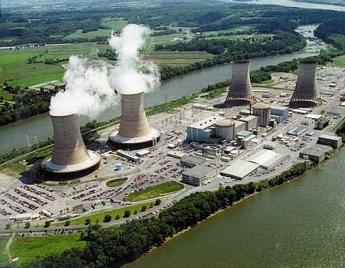
|
| Three Mile Island |
On a mud flat of the Susquehanna River called Three Mile Island, a nuclear energy plant had been built around 1970. The mud flat was in front of the entrance of the Swatara Creek, where Middletown the first town in the County had been laid out in 1732. Later on, the town of Harrisburg became the capital city of Pennsylvania, located a few miles north of the Swatara Creek at what had been called Harris's Ferry, later Harrisburg. For quite a while, Middletown and Hummelstown, also on the Swatara Creek, were the two main towns in the area, but the location of the state capital attracted railroads and steel mills to Harrisburg. One of its main claims to fame was that Confederate General Robert E. Lee was thought to have it as his primary objective for invading the North, frustrated in this goal of course by his defeat at the battle of Gettysburg. Meanwhile, Middletown has declined to a small country town and was therefore originally glad to have the industry of electricity generation located next to it. It's true the huge cooling towers loomed ominously, and huge plumes of evaporated water rose in clouds to be seen for miles. But Middletown slowly took on the look of a refurbished 18th Century town, fancy new restaurants and all, prosperous and waiting to be discovered as a tourist attraction. Maybe in time, it would be the next Williamsburg.
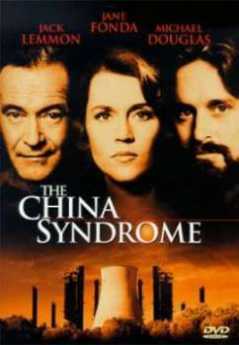
|
| The China Syndrome |
On March 28, 1979, some valve got stuck within Reactor Number Two. The plant had two reactors, each with a spare cooling tower so it looked as though there were four nuclear plants instead of two. Warning lights and whistles went off, and it is easy to imagine a general panic within the operators of the plant, especially since a popular movie, The China Syndrome had just been issued two weeks earlier, depicting an imaginary implosion of a similar nuclear plant with famous movie actresses running around screaming. It took about five days for the plant operators to make a preliminary assessment of the TMI situation, which did not seem as bad as it might have been. It would take six months to reach a final evaluation of just what had gone wrong, and why. In the meantime, almost anyone could say or imagine almost anything; no one could prove they were wrong. The local citizens held a referendum; they wanted all of the facility to be closed, permanently. Secretary of Health Gordon MacLeod wanted a somewhat more reasonable thing, which was large supplies of sodium iodide pills to be distributed to the populace to prevent the radioactive iodine content of escaped gases from being attracted to the thyroid glands of the population, especially children and child-bearing mothers. Unfortunately, he took the unforgivable step of criticizing the state government for not having stock-piled the pills, and the Governor fired him, thus demonstrating strong decisive action in an emergency. The news media were equally at sea because this was big news. When all was finally said and done, there was no evidence that anyone was injured as a result of the accident. More than thirty years later, there is still no sign that anyone was ever hurt.

|
| Hiroshima Explosion |
We might not have been so lucky, of course. When the Russian plant at Chernobyl had a worse accident in 1986, literally thousands of Ukrainians were sickened, and the death rate was appreciable. In Japan, the victims of the Hiroshima explosion were closely followed for many years, and the incidence of cancer of the thyroid among the survivors was truly frightening. However, after more decades elapsed, it was possible to determine that the overall death rate from thyroid cancer was not increased, suggesting these new cancers were not particularly malignant. But in a different set of circumstances, when the Chinese set off their tests of nuclear weapons, it became clear that these tests were followed in a few years by a world-wide epidemic of Hashimoto's Disease of the thyroid. Radioactivity in mushroom clouds is mainly radioactive iodine, with a half-life of seven days. Unfortunately, the clouds sail around the earth, eventually settling into the dirt on the ground. Grass grows there, and cows eat the grass. By this time, the radioactivity is much diminished, but the digestive systems of cows concentrate this weak radioactive iodine, which then gets into milk in a more active form. The kids drink milk and get Hashimoto's disease. Whether they will later get thyroid cancer and die of it remains unknown, but possibly not, in view of the Hiroshima experience. So, amidst a welter of conflicting evidence, it is still possible to say almost anything about nuclear power risks without fear of provable contradiction. It is only safe to repeat that radioactive iodine exposure doesn't do anyone any good.
Unfortunately, thirty years after the accident, we now all understand it would be a good thing to develop energy independence from Middle East sources; but we remain unsure just how unsafe we are willing to become in order to re-adopt nuclear energy. Since the accident at Three Mile Island, our government has made it impossible for a single atomic plant to be built in America. And the politicians are surely right about frightening public opinion on the topic. Just look at pretty little Middletown: it's moving toward becoming a dilapidated ghost town.
Without claiming any expertise in atomic energy production, it is possible to quote others to the effect that the hesitation of the politicians is no longer focused on the danger that a plant will explode. Rather, the real dispute is about the disposal of nuclear waste. No one wants it nearby. The French have built nearly sixty plants in the thirty years we have hesitated; how do the French dispose of nuclear waste? The answer seems to be that waste disposal is not a problem with the French methodology, but a new problem surfaces that the French approach generates a type of waste which is much easier for an undeveloped country to deploy as material for atomic bombs. So, the rumor commonly circulating is that this is really the main practical objection to constructing nuclear energy plants in the French style. As is true for the entire nuclear topic, the rumors outrun the evidence.
13 Blogs
Headwaters of the Middle Atlantic Rivers
 The three main rivers of the Mid-Atlantic states, the Hudson, Delaware and Susquehanna Rivers, share a comparatively small watershed.
The three main rivers of the Mid-Atlantic states, the Hudson, Delaware and Susquehanna Rivers, share a comparatively small watershed.
Great Bend: Joseph Smith Translates the Golden Plates
 Joseph Smith announced he discovered the Golden Plates of Mormonism near Palmyra, NY. He spent three years translating them at his wife's home in Great Bend, Pennsylvania.
Joseph Smith announced he discovered the Golden Plates of Mormonism near Palmyra, NY. He spent three years translating them at his wife's home in Great Bend, Pennsylvania.
La Cosa Nostra Has an Apalachin Outing
 For many years it was widely denied by many, including J. Edgar Hoover, that there was such a thing as organized crime. And then, on November 14, 1957, the State Police stumbled on their national convention in Apalachin, NY.
For many years it was widely denied by many, including J. Edgar Hoover, that there was such a thing as organized crime. And then, on November 14, 1957, the State Police stumbled on their national convention in Apalachin, NY.
Sayre / Athens
 The Susquehanna running due west, takes an abrupt turn south at Sayre, right on the Pennsylvania/New York border.
The Susquehanna running due west, takes an abrupt turn south at Sayre, right on the Pennsylvania/New York border.
Shale Fracking Arrives in Pennsylvania
 Drilling for gas has started in upstate Pennsylvania. It's time to go look at it.
Drilling for gas has started in upstate Pennsylvania. It's time to go look at it.
Azilum: French Asylum on the Susquehanna
The French Revolution and the slave revolt in Haiti created the need for a French-speaking refuge for fleeing aristocrats, and some francophile Philadelphians organized one, including a futile effort to rescue Marie Antoinette.
Wilkes-Barre, Site of the Wyoming Massacre
 Wilkes-Barre has certainly seen better days, but if you speed by without knowing its past, you are missing a lot.
Wilkes-Barre has certainly seen better days, but if you speed by without knowing its past, you are missing a lot.
Wyoming, Fair Wilkes Barre
 The city of Wilkes Barre pretty well fills up the Wyoming Valley, transforming a once famous agricultural paradise into a crowded suburb.
The city of Wilkes Barre pretty well fills up the Wyoming Valley, transforming a once famous agricultural paradise into a crowded suburb.
Wyoming, Fair Wyoming Valley
 Even the present residents of Wilkes-Barre PA would have to giggle at descriptions of the Wyoming Valley written by poets during the Romantic Era. This is where the noble savage originally came from.
Even the present residents of Wilkes-Barre PA would have to giggle at descriptions of the Wyoming Valley written by poets during the Romantic Era. This is where the noble savage originally came from.
Joseph Priestley, Shaker and Mover
 The father of the science of chemistry was also the founder of the Unitarian Church in America.
The father of the science of chemistry was also the founder of the Unitarian Church in America.
Joseph Priestley of Northumberland, PA
 If asked to name the residence of Joseph Priestley, the Father of Modern Chemistry, most people would not think of Northumberland, PA.
If asked to name the residence of Joseph Priestley, the Father of Modern Chemistry, most people would not think of Northumberland, PA.
Bloomsburg / Danville
 Bends in the North Branch of the Susquehanna River created islands and mud flats suitable for farming in the Endless Mountains, but deposits of iron ore were the cause of industrialization at Bloomsburg and Danville.
Bends in the North Branch of the Susquehanna River created islands and mud flats suitable for farming in the Endless Mountains, but deposits of iron ore were the cause of industrialization at Bloomsburg and Danville.
Three-Mile Island
 An ominous-looking nuclear energy plant developed some sort of difficulty, a few miles from the State Capital of Harrisburg. The direct effects were minor, but the political and psychological ones have endured for half a century.
An ominous-looking nuclear energy plant developed some sort of difficulty, a few miles from the State Capital of Harrisburg. The direct effects were minor, but the political and psychological ones have endured for half a century.